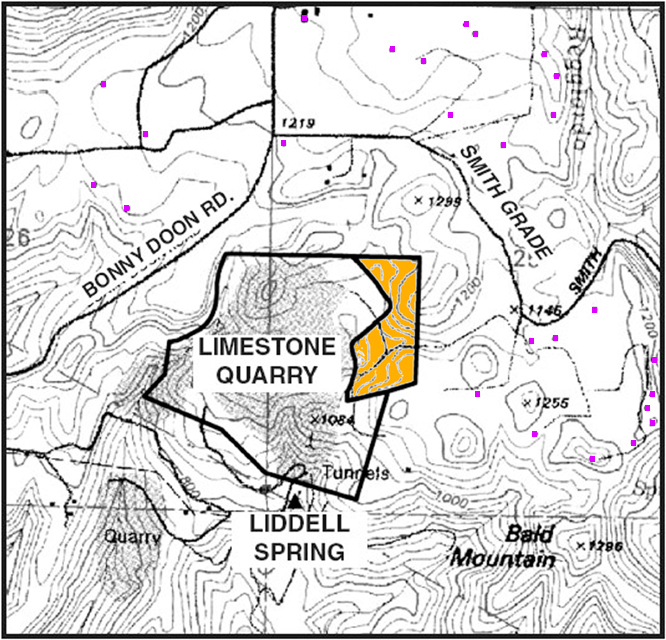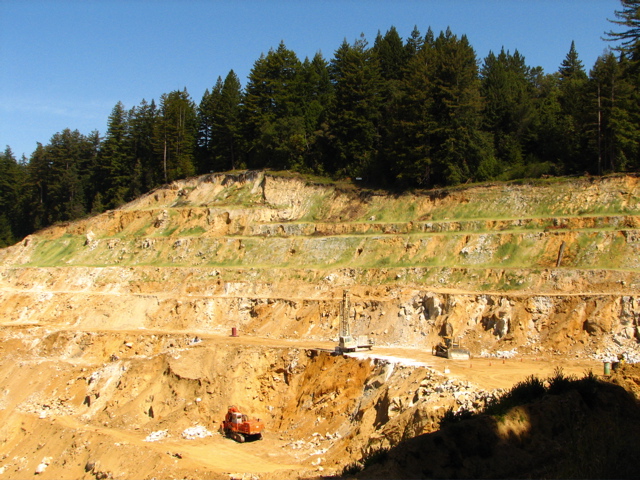|
CEMEX LIMESTONE QUARRY EXPANSION EIR OFFICIALS FROM CEMEX AND SANTA CRUZ COUNTY Monday 10 September 2007, 7:30 PM Yes, MONDAY, NOT WEDNESDAY as usual because of scheduling conflicts of some of the speakers Bonny Doon School Multipurpose Room Ice Cream Grade & Pine Flat Road |
|||||||||||||||||||||
| Hope Springs Eternal for Cemex Quarry Expansion After nearly 10 years of trying to figure out how to expand its limestone quarry without impacting Liddell Spring, source of 8 to 10% of the City of Santa Cruz’s water supply, Cemex is now pushing for the necessary permits. Cemex is faced with only an estimated 5-year supply in the 80-acre quarry, where mining began in 1969. Because the quality of the quarry limestone is so poor, it now must import some high quality material to produce the nearly million tons of cement churned out by the Davenport plant. If it can expand the quarry by 17 acres, it hopes to get another three years’ worth of limestone. Since it would be—perhaps prohibitively—expensive to transport in all the limestone they need, this means that the plant may close in 2015, with a loss of over a hundred jobs and large tax revenues for the county. Cemex has done extensive, costly studies of how the water moves through the complex limestone and marble formations under-laying the surface—a Swiss cheese like geology called a karst formation. In the past, it was never able to prove that the new quarry area wouldn’t increase the silt coming into the Liddell Spring collection box, or decrease its volume. The latest studies, done over the last couple of years by karst experts P.E. LaMoreaux & Associates, included test wells, dyes and other tracing chemicals placed in the area’s many sinkholes and watercourses. All told, the data now includes 225 holes, 40 monitoring wells, driller’s reports from surrounding water wells, precipitation records, x-ray analysis of suspended sediment, and monitoring of the springs and creeks in the area: Laguna, Reggiardo and Liddell. The conclusion: rainfall and flows from the various creeks in the area pass under the quarry and the 17-acre expansion area, and a lot of it flows into Liddell Spring. There are numerous issues mentioned in the recently released Draft Environmental Impact Report (DEIR), which will be the featured topic at the Monday, Sept. 10 RBDA meeting, that could derail the expansion plan. Most significant is the effect on the water quality and quantity in Liddell Spring, a significant source for a city rapidly running out of water. There are also concerns that blasting—four to five tons of explosive per blast, twice a week—could unleash a landslide in the steep canyon south of the quarry that Liddell Spring bursts from. A significant slide occurred not too long ago. The city Water Dept.’s deputy director, Terry Tompkins, says that both siltation and intrusion of nitrates, requiring a lot of expensive removal, have increased in the last 10 years. Cemex’s hydrogeologists have recommended various mitigations to avoid messing up Liddell Spring. However, the feasibility of some, like filtering the silt that accumulates on the quarry floor and runs into the spring, have been questioned by one of their experts. Others, like boreholes to monitor the water table under the new area (state law requires a 20-ft. buffer between the quarry and the water table, but the height of the table varies over time) depend on future studies as the quarrying gets underway. “We want some demonstration that the mitigations would be feasible and effective,” says Tompkins. “That’s not established. A lot could happen during mining operations. We’re uncomfortable with mitigations that depend on future study. Saying that something will work here because it worked elsewhere isn’t a guarantee.” There are other issues, too: the expansion’s effect on steelhead in the streams whose flows could be altered; replacing habitat and relocating the San Francisco Dusky-footed Wood Rat, listed as a species of “special concern;” trying to not disturb nesting raptors; preserving Red-legged Frog habitat; and increased noise and dust in the Bonnymede neighborhood to the east—though Cemex is planning a 1,000 ft. buffer zone. There are also questions whether new state regulations regarding assessments of global warming impacts have been properly dealt with in the DEIR.  Proposed 17-acre expansion area, to the northeast of the present quarry, is tinted orange. Magenta dots are nearby homes. This is the larger existing quarry area, as seen from outer space:  If Cemex gets its permits, it will clear the expansion area of all vegetation and soil down to 80 ft. in two stages over up to two years, starting at the highest elevation. It will harvest and sell the timber and store the slash and topsoil for eventual re-vegetation. Cemex is also seeking to change the reclamation plans for both the shale and limestone quarries, because it now believes the redwoods cannot come back. In fact, it says that no trees will grow at the shale site. It plans to plant native species like sage, coyote brush, sticky monkey flower and lupine, with the hope that oak, madrone and knobcone pine will eventually spring up on the limestone quarry site.  The DEIR is available at the Planning Dept. website (unfortunately, it must be downloaded in pieces) at www.sccoplanning.com/eir.htm. Public comment must be submitted by 5 p.m. on Sept. 30, to Todd Sexauer, Santa Cruz County Planning Dept., 701 Ocean St., Santa Cruz Ca 95060, or by fax to 454-2131. |
|||||||||||||||||||||
| Judge Throws Cold Water on UCSC Expansion On July 13 Superior Court Judge Paul Burdick issued a preliminary ruling that UCSC’s Environmental Impact Report for its Long Range Development Plan (LRDP) failed to live up to California Environmental Quality Act (CEQA) requirements. Judge Burdick gave attorneys for all the parties in the suit—UCSC and the UC Regents vs. the Coalition for Limiting University Expansion (CLUE), the City of Santa Cruz, and Santa Cruz County—time to make further arguments, and rebut each other’s arguments, before issuing a final ruling on Aug. 28, right after this issue of the Highlander goes to press. The biggest problem with the LRDP EIR, according to Judge Burdick, was the growth plan’s dependence on the proposed desalination plant for the increased water required by the addition of 4,500 students and thousands of faculty and support staff—and their families. A pilot plant to study the feasibility of the seawater conversion facility is barely underway, and there are many hurdles, regulatory, financial and environmental, for it to clear before it is built. Judge Burdick called it “paper water” and said it is highly speculative whether and when it will be available. He told UCSC they should have explored water source options on campus as part of the EIR study. Judge Burdick also cited deficiencies in the EIR’s methods of assessing traffic and housing impacts and mitigations. He ruled against CLUE on whether the ways UC Regents allocate growth on the various campuses violate CEQA guidelines. CLUE attorney Stephen Volker of Berkeley argued that the Regents have never methodically approached that issue, and never study the alternative impacts of assigning growth to other or new campuses when the existing campuses draw up their LRDPs. CLUE will probably appeal Judge Burdick’s decision on that point, and UCSC, of course, is expected to appeal the decision to invalidate the EIR. Assuming the final decision doesn’t deviate from the preliminary finding, the campus’s growth will be delayed by months or even years, and all new projects that depended on the EIR, like the huge biomedical sciences building whose construction was imminent, should be halted until the legal process concludes. In the meantime, the City Council is moving forward with putting Measures I & J back on the ballot. They passed with huge majorities but were thrown out on a technicality last spring. The measures would put major obstacles in the way of UCSC building on the North Campus, and force it to pay a larger share of the infrastructure improvements required by its growth. Things That Go Boom in the Morning  We recently received several complaints from neighbors in the Thayer Road area about loud explosions occurring around 6am, sometimes continuing into the morning. Some report that these explosions have been happening regularly for over three months. With the aid of other neighbors, County Planning, and Cemex, which owns vast properties nearby, we’ve been attempting to track down the exact location as well as potential cause, both of which still remain a mystery.  |
|||||||||||||||||||||
| North Coast Off the List for Zero Waste EcoPark Development Santa Cruz County Department of Public Works (DPW) staff continue to make good on their commitment to county residents to avoid opening a new landfill. Instead they have taken a number of successful steps to dramatically reduce the waste stream entering the county landfill at Buena Vista—this past quarter was the lowest volume of waste going into the Buena Vista landfill in recorded history (1989). Steps taken have included mandated recycling, organics diversion into composting, diversion of high volume construction and demolition materials, and transfer of waste to the Marina landfill. DPW staff hosted three public meetings in August around the county to keep residents informed about emerging plans for a creating a new Zero Waste EcoPark. An EcoPark combines materials recovery processing for reuse or recycling, education, and residual waste management in one location, often with retail sales of recovered items. The concept has been successfully implemented in several other communities around the country. Unlike landfill operations, EcoPark facilities are typically large buildings with most operations indoors, providing some protection to the surrounding area from dust, noise, smell, and pests. Planning for the EcoPark is in the very early stages, but there are definitely no locations on the North Coast under consideration. With extensive waste diversion facilities already in place at the Ben Lomond Transfer Station and the City’s landfill on Dimeo Lane off Highway 1, and no suitable sites mid-county, all sites being considered for the new EcoPark are in South County. For more information on the EcoPark development and sites being considered, see www.dpw.co.santa-cruz.ca.us/facilitiessitingproject.htm. RBDA Participating in Roadside Weed Control In early August the RBDA board was contacted by Kirsten Liske of Ecology Action to inquire if we would be interested in becoming involved with an initiative to explore methods of controlling roadside vegetation while minimizing the use of pesticides. The County has historically relied primarily upon spraying as a weed and pest management tool. In 2001 the County adopted an Integrated Pest Management (IPM) policy that is overseen by an IPM Department Advisory Group (DAG) that incorporates broad community and staff representation. However, the plan did not include specific IPM plans for roadside pest species. Because of the challenges presented by vegetation management issues, the lack of an IPM plan and lack of resources for physical controls, the County DAG has authorized exemptions for the continued use of spraying on roadsides. Recently, community pressure led to a short-term ban on the use of any chemicals on the roadsides, and now pest species such as Scotch and French broom are returning full force in the absence of any treatment plan. Ecology Action and the County of Santa Cruz have partnered to submit a Phase 1 Concept Proposal to the Department of Pesticide Regulation’s IPM Alliance Grants Program. As part of the process of putting together the proposal Ecology Action requested the RBDA to become a community representative team member as an advisor on the project. The board agreed that this was a worthy effort, and that it deserved our support, and Treasurer Tom Hearn volunteered to be the liaison person to provide community input to the project. Ecology Action has also solicited the support of the California Native Plant Society as a team member. The grant proposal was submitted in mid-August, Ecology Action expects to hear back from the Department of Pesticide Regulation’s IPM Alliance Grant Program sometime in September if they are interested in the proposal. Petition To Enforce Motorcycle Noise And Traffic Laws Anyone living on a major road in Bonny Doon can attest to the ever increasing numbers of motorcycles touring through our neighborhood each weekend, often traveling well over the speed limit and making a “nuisance” level of noise. Spurred by a request to us from a frustrated resident who has herself tried repeatedly to get the County Sheriff’s office to take action, to no avail, the board will be circulating a petition at the next General Meeting requesting that the CHP and/or Sheriff’s deputy perform weekend patrols on all major Bonny Doon roads to enforce laws regarding speed limits and excessive noise. We’ll deliver the petition with our request to the CHP, with a copy to the Sheriff and Supervisor Neal Coonerty. Board Nominations At November General Meeting The Nominating Committee, led by board member Jane Cavanaugh, is seeking nominees to fill the three board member positions up for re-election in January. This committee will present nominations at the Nov. 14 General Meeting. Nominations from the floor will also be accepted. After this meeting nominations are then closed. Terms for Ben Harmon and Jane Cavanaugh are up in January, as is the empty seat vacated when Andre LaFleur resigned. If you are interested in running for the board, contact Jane or any other RBDA board member for more information. Candidates must have been an RBDA member for at least one month before being nominated, i.e., by Oct. 14. RBDA Executive Board Actions 8/1/07 1. Vote to take part in the roadside weed project; unanimous. 2. Vote to circulate a petition regarding motorcycle noise and speed; unanimous. 3. Vote to decline Cemex offer to be a Highlander sponsor; unanimous. RBDA General Meeting Agenda 9/10/07 1. RBDA Business 2. Featured Program: The Cemex Limestone Quarry Expansion; officials from Cemex and Santa Cruz County
Support Our Sponsors
Frans Lanting Gallery Limited Edition Fine Prints, Books, Calendars by Wildlife & Nature Photographer Frans Lanting 207 McPherson St., Suite D, Santa Cruz 429-1331, www.lanting.com Boyce-Abel Associates & Land Planning Facilitating & Mediating for Families with Land & Other Real Property Transfers 1003 Smith Grade, Bonny Doon CA 95060 469-9223 Become One of Our Sponsors
Sponsorships: $100 a year (6 issues).
Send check and text to: RBDA, 102 Sunlit Lane Bonny Doon CA 95060 |
|||||||||||||||||||||
|
The Highlander
Bonny Doon's voice in preserving our special quality of life,
Send mail correspondence to the Highlander Editor at the above
address,
|
|||||||||||||||||||||
RBDA Executive Board
The Bonny Doon Planning District  If you live in or own property within this district, roughly from Empire
Grade to the ocean and from San Vicente Creek to the City of Santa Cruz
border, you are eligible to be an RBDA member. Please support the RBDA!
Dues payments count for a full year from date received. Dues mostly go for printing and mailing The Highlander, your voice for keeping Bonny Doon rural and natural. Those who make additional contributions qualify as: CONTRIBUTORS ($ 25+ dues) SUSTAINERS ($50+ dues), or PATRONS ($ 100+ dues)
|
